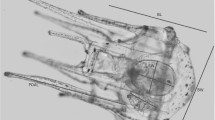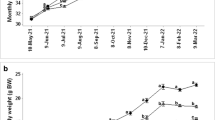Abstract
The efficacy of using agar-bound microparticulate diet (A-MPD) as alternative food for abalone Haliotis asinina Linne post-larvae in large-scale culture was investigated. Larvae sourced from the hatchery-bred (HB) and wild-sourced (WS) broodstock were fed with either diatoms (TMT1-NF), agar-bound microparticulate diet (TMT2-A-MPD), or a combination of both feeds (TMT3-NF + A-MPD) in six 2-m3 tanks replicated over time. Three hundred thousand veliger larvae were stocked/tank containing 80 corrugated plates with mucus trails hanging on bamboo poles. Feeds were given at 0900 h starting at day 3 with seawater flow through introduced every 1400 h starting day 5. Two-way analysis of variance determined significant differences (p < 0.05) in survival and shell length between larval sources and feed types. Tukey’s post hoc test established differences among treatment means. At day 30, survival for HB- and WS-sourced larvae was significantly higher (42%) in TMT3 compared with TMT2 having 35% for HB and 38% for WS (p < 0.05). Larvae fed with TMT1 had significantly lowest survival among the three treatments. Survival at 60 and 90 days did not show significant difference for TMT2 and TMT3 regardless of broodstock source. Post-larval shell growth (90 days), from both sources fed with TMT2 and TMT3, was significantly higher than TMT1 (p < 0.05). Larval performance did not show any significant interactions between HB and WS broodstock. The use of A-MPD alone or in combination may elicit improvement in survival and shell length growth in abalone larvae regardless of larval sources. A-MPD may be used as full or partial replacements to diatoms as alternative food for abalone post-larvae in large-scale culture.




Similar content being viewed by others
Abbreviations
- HB:
-
Hatchery bred
- WS:
-
Wild source
- TMT1-NF:
-
Treatment 1-natural food (1:1 Cocconeis/Nitzschia)
- TMT2-A-MPD:
-
Treatment 2-agar-bound microparticulate diet
- TMT3-NF + A-MPD:
-
Treatment 3-natural food + agar-bound microparticulate diet
- CCA:
-
Crustose coralline algae
- FeCl3 :
-
Ferric chloride
- Na2 EDTA:
-
Sodium ethylenediaminetetraacetic acid
- SEAFDEC/AQD:
-
Southeast Asian Fisheries Development Center/Aquaculture Department
- DOST:
-
Department of Science and Technology
References
Association of Official Analytical Chemists (2007) Official methods of analysis, 16th edition. Washington, DC. Association of Official Analytical Chemists, p 68
Baskerville-Bridges B, Kling LJ (2000) Development and evaluation of microparticulate diets for early weaning of Atlantic cod Gadus morhua larvae. Aqua Nut 6(3):171–182
Bautista-Teruel MN, de la Peña MR, Asutilla AJ (2013) Evaluation of agar-bound microparticulate diet as alternative food in abalone hatchery: effects of agar concentrations and feeding frequencies. J Shell Res 32(1):9–15
Benson R, Dowsett M, Grabski T and Geedes P (2001) The effect of shelter type on growth and survival in juvenile greenlip abalone, Haliotis laevigata (Donovan). Curtin University of Technology.Western Australia. Retrieved from http://www.adamamos.com/rbenson.htm.
Campbell A (2000) Review of northern abalone, Haliotis kamtschatkana, stock status in British Columbia. IN Proceedings of the Workshop on Rebuilding Abalone Stocks in British Columbia. (edts). A Campbell Can Spec Publ Fish Aquat Sci 130: 41–50
Carbajal-Miranda MJ, Sanchez-Saavedre MDP, Simental JA (2005) Effects of monospecific and mixed benthic diatoms cultures on the growth of red abalone post-larvae Haliotis rufescens (Swainson 1822). J Shellfish Res 24(2):401–405
Daume S, Brand-Gardner S, Woelkerling WJ (1999) Preferential settlement of abalone larvae: diatom films vs. non-geniculate coralline algae. Aqua 174:243–254
Daume S, Krsinich S, Farell S, Gervis M (2000) Settlement, early growth and survival of Haliotis rubra in response to different algal species. J Appl Phycol 12:479–488
Daume S, Ryan S (2004) Fatty acid composition of eggs derived from conditioned and wild-caught greenlip abalone broodstock, Haliotis laevigata. J Shellfish Res 23(4):967–974
de la Peña MR (2007) Cell growth and nutritive value of the tropical benthic diatom Amphora sp., at varying levels of nutrients and light intensity, and different culture locations. J Appl Phycol 19:647–655
de la Peña MR, Bautista JI, Buen-Ursua SM, Bayona N, Titular VS (2010) Settlement, growth and survival of the donkey’s ear abalone, Haliotis asinina (Linne) in response to diatom diets and attachment substrate. Phil J Sci 139:127–133
Encena II VC, NC Bayona (2010) Farming of the tropical abalone Haliotis asinina. Southeast Asian Fisheries Development Center Aquaculture Department.
Erasmus JH, Cook PA, Coyne VE (1996) The role of bacteria in the digestion of seaweed by the abalone Haliotis midae. Aqua 155(1):377–386
Fermin AC, MR de la Peña, RSJ Gapasin, MB Teruel, SM Ursua, VC Encena II, NC Bayona (2008) Abalone hatchery. Aquaculture Extension Manual No. 39. Aquaculture Department, Southeast Asian Fisheries Development Center, Tigbauan, Iloilo, Philippines.
Graham F, Mackrill T, Davidson M, Daume S (2006) Influence of conditioning diet and spawning frequency on variation in egg diameter for greenlip abalone, Haliotis laevigata. J. Shellfish Res 25:195–200
Hindrum SM, Maquire GB, Edwards SJ, Burke CM, and John DR (2008) Is the need for refuge in abalone culture dependent on stocking density for greenlip abalone? Proceedings of the 5th Annual Abalone Aquaculture Workshop July 1–4, 2008. Fisheries Research and Development Corporation. (Abalone Aquaculture Sub-program), SA, 5, 1
Jones DA, Kanazawa A, Abdel-Rahman S (1979) Studies on the presentation of artificial diets for rearing larvae of P. japonicas Bate. Aqua 17:33–43
Kawamura T, Saido T, Takami H, Yahmashita Y (1995) Dietary value of benthic diatoms for the growth of postlarval abalone, Haliotis discus hannai. J Exp Mar Biol Ecol 194:189–199
Kawamura T (1996) The role of the benthic diatoms in the early life stages of the Japanese abalone Haliotis discus hannai. In: Watanabe Y, Yamashita Y, Oozehi Y (eds) Survival strategies in early life stages of marine resources. Balkema, Rotterdam, pp 355–367
Kawamura T, Roberts RD, Takami H (1998) A review of the feeding and growth of postlarval abalone. J Shell Res 17:615–625
Lanes CFC, Bizuayehu TT, Bolla S, Martins C, de Oliveira Fernandes JM, Bianchini A, Kiron V, Babiak I (2012) Biochemical composition and performance of Atlantic cod (Gadusmorhua L.) eggs and larvae obtained from farmed and wild broodstocks. Aqua 324:267–275
Menasveta P, Piyatiratitivorakul S, Rungsupa S, Moree N, Fast AW (1993) Gonadal maturation and reproductive performance of giant tiger prawn (Penaeus monodon Fabricius) from the Andaman Sea and pond-reared sources in Thailand. Aqua 116(2–3):191–198
Menasveta P, Sangpradub S, Piyatiratitivorakul S, Fast AW (1994) Effects of broodstock size and source on ovarian maturation and spawning of Peñaeus monodon Fabricius from the Gulf of Thailand. J World Aqua Soc 25(1):41–49
Nelson MM, Leighton DL, Phleger CF, Nichols PD (2002) Comparison of growth and lipid composition in the green abalone, Haliotis fulgens, provided specific macroalgal diets. Comp Biochem Physiol B: Biochem Mol Biol 131(4):695–712
Norman-Boudreau K, Burns D, Cooke CA (1986) A simple technique for detection of feeding in newly metamorphosed abalone. Aquaculture 51:313–317
Onal U, Langdon C (2000) Characterization of two microparticle types for delivery of food to artificial fish larvae. Aqua Nut 6(3):159–170
Pousão-Ferreira P, Santos P, Carvalho AP, Morais S, Narciso L (2003) Effect of an experimental microparticulate diet on the growth, survival and fatty acid profile of gilthead seabream (Sparus aurata L.) larvae. Aquac Int 11:491–504
Searcy-Bernal R, Espino LA, Anguiano-Beltran C (2001) Effect of biofilm density on grazing and growth rates of Haliotis fulgens post-larvae. J. Shellfish Res 20:587–591
Slattery M (1992) Larval settlement and juvenile survival in the red abalone (Haliotis rufescens), an examination of inductive cues and substrate selection. Aqua 102(1):143–153
Southgate PC, Lee PS, Lucas JS (1992) Development of artificial diets for bivalve larvae. In: Allan GL, Dall W (eds) Proceedings of the Aquaculture Nutrition Workshop. Salamander Bay, New South Wales, NSW Fisheries, Brackishwater Fish Culture Research Unit, pp 156–164
Stott A, Takeuchi T, Koike Y, Yamakawa H, Imada O (2002) Using microparticle diets to replace diatoms for feeding postlarval abalone Haliotis discus discus (Reeve.). Fish Sci 68(5):1088–1093
Stott AE, Takeuchi T, Koike Y, Imada O (2003) Settling and raising post-larval abalone Haliotis diversicolor supertexta (Lischke) on microparticulate diets embedded in a layer of alginate. Aqua Res 34:561–567
Stott AE, Takeuchi T, Koike Y (2004) An alternative culture system for the hatchery production of abalone seed without using live food. Aqua 236:341–360
Takami H, Kawamura T, Yamashita Y (1997a) Survival and growth rates of post-larval abalone, Haliotis discus hannai fed conspecific trail mucus and/or benthic diatom, Coconeis cutellum var. parva. Aquaculture 152(1):129–138
Takami H, Kawamura T, Yamashita Y (1997b) Contribution of diatoms as food sources for post-larval abalone Haliotis discus hannai on a crustose corraline alga. Molluscan Research 18(2):143–151
Takami H, Kawamura T, Yamashita Y (1998) Development of polysaccharide degradation activity in postlarval abalone Haliotis discus hannai. J Shell Res 17(3):723–728
Uki N, Watanabe T (1992) Review of the nutritional requirements of abalone, Haliotis spp. and development of more efficient artificial diets. Abalone of the world biology, fisheries, and culture. Fishing News Books, Oxford, pp 504–517
Acknowledgements
The authors would like to thank SEAFDEC/AQD (study code 5309-TTV-MO-312T) through its chief Dr. Felix Ayson and DOST for the funds provided; the SEAFDEC/AQD Abalone hatchery staff: Mr. Rafael Barrido, Mr. Ramil Piloton, and Mr. Nestor Bayona for their valuable suggestions in carrying out post-larval rearing work; Ms. Rena Santizo and Ms. Analyn Asutilla for their significant help and contribution in the study; and Mr. Richard Tantiado for the technical assistance in the conduct of experiment.
Author information
Authors and Affiliations
Corresponding author
Rights and permissions
About this article
Cite this article
Bautista-Teruel, M., Maquirang, J., dela Peña, M. et al. Use of agar-bound microparticulate diet as alternative food for tropical abalone, Haliotis asinina (Linnaeus 1758) post-larvae in large-scale cultures. Aquacult Int 25, 1239–1252 (2017). https://doi.org/10.1007/s10499-017-0110-9
Received:
Accepted:
Published:
Issue Date:
DOI: https://doi.org/10.1007/s10499-017-0110-9




